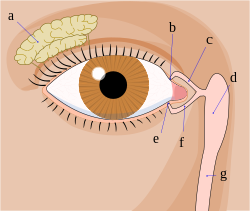Nasolacrimal duct obstruction

Editor-In-Chief: Prab R Tumpati, MD
Obesity, Sleep & Internal medicine
Founder, WikiMD Wellnesspedia &
W8MD medical weight loss NYC and sleep center NYC
| Nasolacrimal duct obstruction | |
|---|---|

| |
| Synonyms | Dacryostenosis |
| Pronounce | N/A |
| Specialty | N/A |
| Symptoms | Epiphora, eye infection |
| Complications | Dacryocystitis, conjunctivitis |
| Onset | Infancy or adulthood |
| Duration | Can be chronic |
| Types | N/A |
| Causes | Congenital blockage, trauma, infection, inflammation |
| Risks | Age, sinusitis, facial trauma |
| Diagnosis | Clinical examination, fluorescein dye disappearance test, imaging |
| Differential diagnosis | Conjunctivitis, allergic rhinitis, dry eye syndrome |
| Prevention | N/A |
| Treatment | Lacrimal probing, balloon dacryoplasty, dacryocystorhinostomy |
| Medication | Antibiotics for infection |
| Prognosis | N/A |
| Frequency | Common in infants |
| Deaths | N/A |

Nasolacrimal Duct Obstruction is a medical condition that occurs when the nasolacrimal duct, a structure responsible for draining tears from the eyes to the nose, becomes blocked. This condition is common in infants but can also occur in adults due to infection, inflammation, or trauma.
Causes[edit]
The most common cause of nasolacrimal duct obstruction in infants is the failure of the membrane at the end of the nasolacrimal duct, known as the Hasner's valve, to open fully at birth. In adults, the obstruction can be caused by a variety of factors including infection, inflammation, trauma, or tumors.
Symptoms[edit]
The primary symptom of nasolacrimal duct obstruction is excessive tearing, known as epiphora. Other symptoms may include mucus or pus discharge from the eyes, redness, and swelling in the inner corner of the eyes.
Diagnosis[edit]
Diagnosis of nasolacrimal duct obstruction is typically made through a physical examination and a detailed medical history. Additional tests such as dacryocystography, a type of X-ray imaging, may be used to confirm the diagnosis and determine the exact location of the obstruction.
Treatment[edit]
Treatment for nasolacrimal duct obstruction depends on the cause and severity of the condition. In infants, the condition often resolves on its own within the first year of life. In adults, treatment options may include antibiotics for infection, steroids for inflammation, or surgery for severe cases.
See Also[edit]
Ad. Transform your life with W8MD's Budget GLP-1 injections from $75


W8MD offers a medical weight loss program to lose weight in Philadelphia. Our physician-supervised medical weight loss provides:
- Weight loss injections in NYC (generic and brand names):
- Zepbound / Mounjaro, Wegovy / Ozempic, Saxenda
- Most insurances accepted or discounted self-pay rates. We will obtain insurance prior authorizations if needed.
- Generic GLP1 weight loss injections from $75 for the starting dose.
- Also offer prescription weight loss medications including Phentermine, Qsymia, Diethylpropion, Contrave etc.
NYC weight loss doctor appointmentsNYC weight loss doctor appointments
Start your NYC weight loss journey today at our NYC medical weight loss and Philadelphia medical weight loss clinics.
- Call 718-946-5500 to lose weight in NYC or for medical weight loss in Philadelphia 215-676-2334.
- Tags:NYC medical weight loss, Philadelphia lose weight Zepbound NYC, Budget GLP1 weight loss injections, Wegovy Philadelphia, Wegovy NYC, Philadelphia medical weight loss, Brookly weight loss and Wegovy NYC
|
WikiMD's Wellness Encyclopedia |
| Let Food Be Thy Medicine Medicine Thy Food - Hippocrates |
Medical Disclaimer: WikiMD is not a substitute for professional medical advice. The information on WikiMD is provided as an information resource only, may be incorrect, outdated or misleading, and is not to be used or relied on for any diagnostic or treatment purposes. Please consult your health care provider before making any healthcare decisions or for guidance about a specific medical condition. WikiMD expressly disclaims responsibility, and shall have no liability, for any damages, loss, injury, or liability whatsoever suffered as a result of your reliance on the information contained in this site. By visiting this site you agree to the foregoing terms and conditions, which may from time to time be changed or supplemented by WikiMD. If you do not agree to the foregoing terms and conditions, you should not enter or use this site. See full disclaimer.
Credits:Most images are courtesy of Wikimedia commons, and templates, categories Wikipedia, licensed under CC BY SA or similar.
Translate this page: - East Asian
中文,
日本,
한국어,
South Asian
हिन्दी,
தமிழ்,
తెలుగు,
Urdu,
ಕನ್ನಡ,
Southeast Asian
Indonesian,
Vietnamese,
Thai,
မြန်မာဘာသာ,
বাংলা
European
español,
Deutsch,
français,
Greek,
português do Brasil,
polski,
română,
русский,
Nederlands,
norsk,
svenska,
suomi,
Italian
Middle Eastern & African
عربى,
Turkish,
Persian,
Hebrew,
Afrikaans,
isiZulu,
Kiswahili,
Other
Bulgarian,
Hungarian,
Czech,
Swedish,
മലയാളം,
मराठी,
ਪੰਜਾਬੀ,
ગુજરાતી,
Portuguese,
Ukrainian

